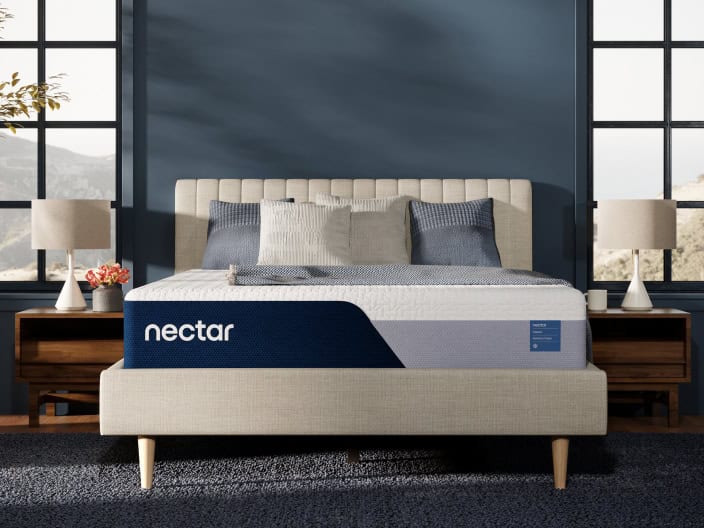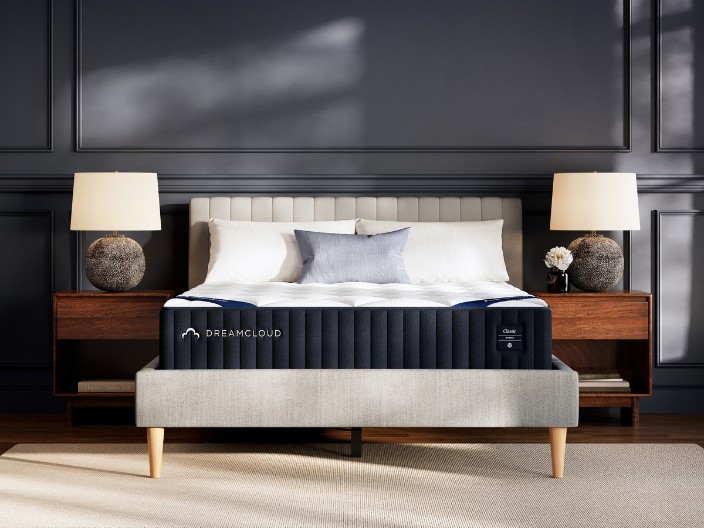Foam vs. Spring Mattress: Which Is Best?
Share
Fact checked
Reviewed by experts
Updated
December 22, 2022
Quick read
5 mins to read
List of Content
A study in 2002 found that a comfortable mattress can help you get a good quality sleep. But the question is, which is a comfortable mattress? Spring beds were an obvious choice till the 1990s, before the memory foam mattress came into the picture. Considering the popularity and strengths of both these mattresses, it becomes very tricky at times to choose the perfect bed. Our detailed guide will help you decide the right option between foam vs. spring mattresses.
What is a Foam Mattress?
Foam mattresses are made of foam composed of polyurethane and other chemicals that increase their viscosity and density. Memory foam tends to conform easily with the sleeper’s body shape, and it provides the necessary support to the joints. It distributes the weight of the sleeper uniformly leading giving comfort to the sleeper’s body. The lifespan of a foam mattress is between 10 to 12 years.
Types of Foam Mattresses
Polyurethane Foam
Polyurethane foam or polyfoam are made from polyurethane, composed of organic units joined by carbamate links. It has more bounce and spring compared to memory foam. Polyfoam comes in three types.
- Regular polyfoam: It is one of the softest polyfoams. It is used mainly in the topmost layers of spring or foam beds.
- High-density polyfoam: It is much harder than regular polyfoam. It is mainly used in the supporting layers.
- High-resiliency polyfoam: It is the hardest of all and is used in the underlying bottom layers. It provides significant support and is very costly compared to others.
Memory Foam
The most popular and commonly used foam is memory foam. It is produced from polyurethane materials and added chemicals to increase properties such as density and viscosity. Memory foam quickly conforms to the shape of the sleeper’s body. It provides excellent support to your body and distributes the pressure uniformly.
- Standard memory foam: Standard memory foam is very fluffy and provides support. It is very affordable.
- Open-cell memory foam: It consists of tiny or open cells of the foam. Open-cell memory foam allows smooth passage of air. Open-cell foam is generally soft material with good heat-resistant properties.
- Gel memory foam: Gel memory foam has small gel pellets inserted into the memory foam. This combination of a gel and open cell structure leads to a smooth air passage and facilitates cooling.
Latex Foam
Latex is a natural foam extracted from rubber trees. Latex foam is naturally bouncier and springy. Latex foam is known for its biodegradable nature. It is much more expensive than a traditional foam mattress.
- Dunlop latex: It is produced using a conventional process and provides firm support.
- Talalay latex: Talalay latex foam is made using a latex rubber in a closed mold with vacuumed air. It is known for its extreme bounciness and firm support.
Pros and Cons of Memory Foam Mattress
Here are some pros and cons of foam mattresses.
Pros
- Conforms easily to the shape of the sleeper
- Supports the joints, back, and spine alignment
- Allows smooth heat distribution
- Excellent mattress people who love to sleep with partners as it tends to absorb body movements
- Provides good pressure relief
- Available in all price ranges
Cons
- Chemical usage may lead to a foul odor
- Sags with time
- The weight is more compared to other mattresses
What Is a Spring Mattress?
Spring mattress was discovered by Berliner Heinrich Westphal in the late 1800s. It is the first modern mattress and is also referred to as Innerspring Mattresses. Spring mattresses are much firmer and provide excellent support to people with lower back issues and heavier sleepers. This mattress is ideal for people who love sleeping on their sides or back.
Types of Spring
There are four different types of springs depending on the structure and type of coils used.
Offset coils
Offset coils are composed of sandglass-type coils that are flattened at the top and bottom combined. These coils are connected through helical wires. Offset coils easily conform to the sleeper’s body and have good durability.
Bonnell coils
Bonnell coils are the oldest type of coil. Bonnell coils are sandglass-shaped coils made of steel wire. They are connected through the spiral wire and sink when weight is applied. It is the most affordable type of coil.
Continuous coils
Continuous coils consist of S-shaped coils connected in a single piece of wire. They operate in hinging effect and offer fantastic support, and create a motion-isolating feature. They provide more support compared to Bonnell cells.
Pocket coils
Pocket coils, also known as Marshall coils, are cask-shaped, knotless coils draped in fabric. This unique pattern allows each coil to operate flawlessly and absorb the pressure. Pocket spring mattresses are much costlier compared to other spring mattresses.
Pros and Cons of Spring Mattress
Here are some pros and cons of spring mattresses.
Pros
- Excellent support for side and back sleepers
- Suitable for sleepers with lower back issues
- Much affordable compared to foam mattresses
- More bouncy and springy as than foam mattress
- Facilitates smooth air passage due to coil arrangement
Cons
- Produces crunchy sound at times
- Sleepers may feel the movement of their partner while sleeping
- Less durability
- Mattress may sink with aging
Let’s understand the differences between foam mattresses vs. spring in the next section.
Difference Between Memory Foam and Spring Mattress
The table below covers all the significant differences between spring vs. foam mattresses.
| Factors | Spring Mattress | Memory Foam Mattress |
|---|---|---|
| Durability | Less durable than foam mattress due to sagging issues | Memory foam is more durable than a spring mattress |
| Body Support | Firm support to sleeper’s body but not uniform | It easily conforms to the sleeper’s body and supports uniformly |
| Recovery & Bouncing Properties | More bounce and springiness compared to foam mattress | It takes time to return to its original shape and hence has less bounce than a spring mattress |
| Pain-relief | Does not help with even distribution of weight and hence may worsen the pain at times | Provides excellent support to the shoulder, lower back, and spine and alleviates pain |
| Motion Transfer Isolation | Bad at isolating motion | Great at restricting motion transfer |
| Temperature Regulation | The coil arrangement makes air passage smooth and helps in temperature regulation | Retains more heat compared to a spring mattress |
| Cost | Less expensive than foam mattress and available in different price range. | Expensive compared to a spring mattress and generally comes in a higher price range. |
Which One Is Better: Foam or Spring Mattress
By now, you have understood the differences between spring mattresses vs. foam mattresses. It is very challenging to pick a single bed; however, it depends on many factors.
If you sleep with a partner and want motion isolation, a foam mattress is ideal. Also, if you want a soft feel and a bed that contours to the shape of your body, then a foam bed is your best bet.
For sleepers facing lower back and shoulder issues, a spring mattress might be a good option for you.
The Final Word
There is a considerable difference between the mattress types, and it’s essential to thoroughly research their pros, cons, and differences before deciding to go with either spring or foam mattresses. Hopefully, our detailed guide will help you in deciding your next mattress. If you are still unable to choose between the two, we recommend you try a hybrid mattress that covers the features of both bed types.
Happy Sleeping!
FAQs
People with back pain should buy a memory foam mattress or a natural latex mattress that improves blood circulation, posture and distributes weight uniformly to reduce back pain.
There is not a huge difference between the cost of memory foam vs. spring mattresses. The price depends on the type and quality of mattresses and typically ranges between $300 to $1500 for high-quality mattresses.
Generally, foam mattresses last longer than spring mattresses due to sagging issues in spring mattresses.
Memory foam mattresses conform to your body shape and distribute the pressure uniformly. It reduces pain, improves sleep quality, and improves spinal alignment.
This website does not offer medical advice nor professional medical services; rather, it is provided solely for educational, informational, and/or entertainment purposes. Individuals seeking medical advice should consult a licensed physician. The information provided should not be used for diagnosis or treatment of any condition, disease, or injury. When you have a medical condition, you should always talk to licensed doctor or other certified medical professional. You should never delay seeking professional medical advice or treatment based on the contents of this website. Call 911 or immediately go to the nearest emergency room if you think you may have a medical emergency. The contents of this website are provided “as-is”, Sleep Authority and its parent, subsidiaries, affiliates, employees, contributors disclaim any warranty of the information contained herein. Please contact using contact form to report any errors, omissions, misinformation, or abuse.




